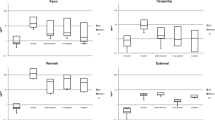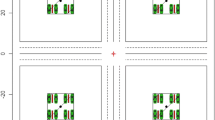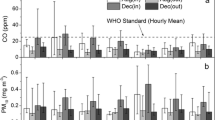Abstract
We measured levels of VOCs and determined the distributions of benzene concentrations over the area of two petrol stations in all three seasons. Using the concentrations and sampling positions, we created isoconcentration contour maps. The average concentrations ranged 18–1288 μg m−3 for benzene and 12–81 μg m−3 for toluene. The contour maps indicate that high-level contours of benzene were found not only at the fuel dispenser areas but also at the storage tank refilling points, open drainage areas where gasoline-polluted wastewater was flowing, and the auto service center located within the station area. An assessment of the benzene to toluene ratio contour plots implicates that airborne benzene and toluene near the fuel dispenser area were attributed to gasoline evaporation although one of the studied stations may be influenced by other VOC sources besides gasoline evaporation. Additionally, during the routine refilling of the underground fuel storage tanks by a tank truck, the ambient levels of benzene and toluene increased tremendously. The implementation of source control by replacing old dispensers with new fuel dispensers that have an efficient cutoff feature and increased delivery speed can reduce spatial benzene concentrations by 77 %. Furthermore, a questionnaire survey among 63 service attendants in ten stations revealed that headache was the most reported health complaint with a response rate of 32 %, followed by fatigue with 20 %. These prominent symptoms could be related to an exposure to high benzene concentrations.






Similar content being viewed by others
References
Andersson K, Stridh G, Fagerlund I, Aslaksen W (2005) Manual: work environment—MM Questionnaire, Department of Occupational and Environmental Medicine, Örebro University Hospital, Örebro, Sweden
Atkinson R (2007) Gas-phase tropospheric chemistry of organic compounds: a review. Atmos Environ 41:200–240
ATSDR (2000) Toxicological profile for toluene. Agency for Toxic Substances and Disease Registry, US department of Health and Human Services, Georgia, USA. http://www.atsdr.cdc.gov/toxprofiles/tp.asp?id=161&tid=29. Accessed 20 Nov 2014
Cruz-Núñez X, Hernández-Solís JM, Ruiz-Suárez LG (2003) Evaluation of vapor recovery systems efficiency and personal exposure in service stations in Mexico City. Sci Total Environ 309:59–68
DEDE (2013) Table of Thailand energy balance 2013. Department of Alternative Energy Development and Efficiency, Ministry of Energy, Bangkok, Thailand. http://www.dede.go.th/dede/index.php?option=com_content&view=article&id=1841&Itemid=318&lang=th. Accessed 20 Nov 2014 (in Thai)
DOEB (2010) Promulgation for determination of properties and qualities of regular gasoline. Department of Energy Business, Ministry of Energy, Bangkok, Thailand. http://www.ratchakitcha.soc.go.th/DATA/PDF/2553/E/044/36.PDF. Accessed 3 March 2015 (in Thai)
DOEB (2013) A number of petrol stations in Thailand: Quarter 3/2013. Department of Energy and Business, Ministry of Energy, Bangkok, Thailand. http://www.doeb.go.th/info/info_sta_quarter.php. Accessed 20 Nov 2014 (in Thai)
DOEB (2014) Promulgation for determination of properties and qualities of gasohol. Department of Energy Business, Ministry of Energy, Bangkok, Thailand. http://elaw.doeb.go.th/document_doeb/424_0001.pdf. Accessed 3 March 2015 (in Thai)
Filley CM, Halliday W, Kleinschmidt-DeMasters BK (2004) The effects of toluene on the central nervous system. J Neuropathol Exp Neurol 63:1–12
Greenberg MM (1997) The central nervous system and exposure to toluene: a risk characterization. Environ Res 72:1–7
Hassanvand A, Hashemabadi SH, Bayat M (2010) Evaluation of gasoline evaporation during the tank splash loading by CFD techniques. Int Commun Heat Mass Transf 37:907–913
ICCT (2014) China V gasoline and diesel fuel quality standards. The International Council on Clean Transportation. http://www.theicct.org/sites/default/files/publications/ICCTupdate_ChinaVfuelquality_jan2014.pdf. Accessed 3 March 2015
IPCS (1986) Chemical environmental health criteria 52: toluene. International Programme on Chemical Safety. http://www.inchem.org/documents/ehc/ehc/ehc52.htm. Accessed 20 Nov 2014
Karakitsios SP, Papaloukas CL, Kassomenos PA, Pilidis GA (2007) Assessment and prediction of exposure to benzene of filling station employees. Atmos Environ 41:9555–9569
Kotseva K, Popov T (1998) Study of the cardiovascular effects of occupational exposure to organic solvents. Int Arch Occup Environ Health 71:S87–S91
Kraut A, Lilis R, Marcus M, Valciukas JA, Wolff MS, Landrigan PJ (1988) Neurotoxic effects of solvent exposure on sewage treatment workers. Int Arch Occup Environ Health 43:263–268
Matsuoka M (2007) Neurotoxicity of organic solvents—recent findings. Brain Nerve 59:591–596
MDE (2007) BTEX. Maryland Department of the Environment, Maryland, USA. http://www.mde.state.md.us/assets/document/OilControl/Fact_Sheet_BTEX.pdf. Accessed 22 June 2014
Morales Terrés IM, Miñarro MD, Ferradas EG, Caracena AB, Rico JB (2010) Assessing the impact of petrol stations on their immediate surroundings. J Environ Manag 91:2754–2762
National Environment Board (2007) Notice of the National Environmental Board No.30 (B.E. 2550) on standards of one-year average limit of volatile organic compounds, Bangkok, Thailand. http://www.pcd.go.th/info_serv/reg_std_airsnd01.html. Accessed 20 Nov 2014 (in Thai)
NIOSH (2003) NIOSH manual of analytical methods for aromatic hydrocarbons—method 1501. The National Institute for Occupational Safety and Health, Centers for Disease Control and Prevention, Georgia
Okamoto K, Watanabe N, Hagimoto Y, Miwa K, Ohtani H (2009) Changes in evaporation rate and vapor pressure of gasoline with progress of evaporation. Fire Saf J 44:756–763
Paulauskiene T, Zabukas V, Vaitiekūnas P (2009) Investigation of volatile organic compound (VOC) emission in oil terminal storage tank parks. J Environ Eng Landsc Manag 17:81–88
Periago JF, Zambudio A, Prado C (1997) Evaluation of environmental levels of aromatic hydrocarbons in gasoline service stations by gas chromatography. J Chromatogr A 778:263–268
Polakowska B (1985) Headaches in female workers in the rubber industry exposed to benzene vapors. Med Pr 36:139–144
Rosenberg NL, Spitz MC, Filley CM, Davis KA, Schaumburg HH (1988) Central nervous system effects of chronic toluene abuse—clinical, brainstem evoked response and magnetic resonance imaging studies. Neurotoxicol Teratol 10:489–495
Senzolo C, Frignani S, Pavoni B (2001) Environmental and biological monitoring of occupational exposure to organic micropollutants in gasoline. Chemosphere 44:67–82
Thaveevongs P, Panyamateekul S, Prueksasit T (2010) Exposure risk assessment of volatile organic compounds (VOCs) of the workers at gas station in Bangkok. Eng J 2:1–12
Tunsaringkarn T, Siriwong W, Rangsiyothin A, Nopparatundit S (2012) Occupational exposure of gasoline station workers to BTEX compounds in Bangkok, Thailand. Int J Occup Environ Med 3:117–125
Tunsaringkarn T, Sukarun S, Rangsiyothin A, Thappitaksak B, Sapaung K (2009) Health of service attendants in petrol stations located in Phathumwan district in 2009. Surveillance Center on Health and Public Health Problem, College of Public Health Sciences, Chulalongkorn University, Bangkok (in Thai)
US EPA (2003) Toxicological review of benzene (non cancer effects): in support of summary information on integrated risk information system (IRIS). U.S. Environmental Protection Agency, Washington DC, USA. www.epa.gov/iris. Accessed 20 Nov 2014
US EPA (2004) Revised assessment of detection and quantitation approaches. U.S. Environmental Protection Agency, Engineering and Analysis Division Office of Science and Technology Office of Water (4303T), Washington DC, USA, EPA-821-B-04-005
US EPA (2005) Toxicological review of toluene: in support of summary information on integrated risk information system (IRIS). U.S. Environmental Protection Agency, Washington DC, USA. www.epa.gov/iris. Accessed 20 Nov 2014
Vojdania A, Lapp CW (1999) Interferon-induced proteins are elevated in blood samples of patients with chemically or virally induced chronic fatigue syndrome. Immunopharmacol Immunotoxicol 21:175–202
Wark K, Warner CF, Davis WT (1998) Air pollution: its origin and control, 3rd edn. Addison-Wesley, Massachusetts
Wiwanitkit V (2007) Benzene exposure and hypertension: an observation. Cardiovasc J Afr 18:264–265
Wiwanitkit V (2008) Headaches in subjects occupationally exposed to benzene vapors. J Headache Pain 9:253–254
Zhang Y, Wang X, Zhang Z, Lü S, Shao M, Lee FSC (2013) Species profiles and normalized reactivity of volatile organic compounds from gasoline evaporation in China. Atmos Environ 79:110–118
Acknowledgments
The materials used were funded by a Research and Researchers grant for Industries-RRI, Thailand Research Fund (TRF) under the contract no. MSD57I0132 and Roi-et Phakthichai Ltd. Part. We also thank Mahasarakham University Development Fund and Centre of Laboratory Equipment as well as the petrol stations participating in this study.
Author information
Authors and Affiliations
Corresponding author
Additional information
Responsible editor: Philippe Garrigues
Rights and permissions
About this article
Cite this article
Sairat, T., Homwuttiwong, S., Homwutthiwong, K. et al. Investigation of gasoline distributions within petrol stations: spatial and seasonal concentrations, sources, mitigation measures, and occupationally exposed symptoms. Environ Sci Pollut Res 22, 13870–13880 (2015). https://doi.org/10.1007/s11356-015-4615-3
Received:
Accepted:
Published:
Issue Date:
DOI: https://doi.org/10.1007/s11356-015-4615-3




